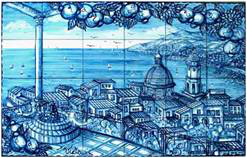Speaker
Ms
Julia Hess
(Research Unit of Radiation Cytogenetics, Helmholtz Zentrum München, German Research Center for Environmental Health, Neuherberg, Germany)
Description
The main consequence of the Chernobyl accident has been an increase in childhood papillary thyroid carcinomas (PTC) in the contaminated areas. Consequently, we aimed to identify genomic radiation biomarkers.
Within the EU-funded project GENRISK-T we analysed 80 PTC from patients that were matched for age at diagnosis, sex and residence. DNA and RNA from the tumours were provided by the Chernobyl Tissue Bank. The cohort consisted of patients exposed (born before the Chernobyl reactor accident) and not exposed (control group, born at least one year after the accident; median age 1.5 years at the time of exposure) to radioiodine fallout. Array CGH was performed to detect copy number alterations in the tumours. We found that gain of the chromosome band 7q11.22-11.23 was associated (FDR=0.035) with exposure to radioiodine fallout. 39% from the exposed group and none from the unexposed group showed the alteration. Since only a subgroup of cases in the exposed group exclusively showed gain of chromosome band 7q11, it is likely that different molecular subgroups and routes of radiation-induced carcinogenesis exist. Candidate genes (n=56) from the gained region showed enrichment of GO (Gene Ontology) terms associated with “DNA repair” (PMS2L3, PMS2L5), “response to DNA damage stimulus” (BAZ1B, PMS2L3, PMS2L5, RFC2), and “cell–cell adhesion” (CLDN3, CLDN4). The mRNA expression of the genes PMS2L11, PMS2L3, and STAG3L3 correlated with gain of 7q11.22-11.23. In particular, CLIP2 was shown to be specifically overexpressed in the radiation-exposed cases at the mRNA and protein level (IHC). In order to characterise the function of CLIP2 and its so far unknown role in radiation-induced carcinogenesis we aim to identify the functional network that interacts with the CLIP2 protein. Therefore a CLIP2 correlation network from global mRNA expression data from PTC was calculated. The resulting gene list was analysed using different biological databases. In order to reconstruct the CLIP2 interactome time-series data of global mRNA expression from an in vitro cell culture model of PTC after perturbation by siRNA knockdown of CLIP2 expression are currently carried out.
This study shows that genomic radiation markers provide novel insights into the radiation-related carcinogenesis of young onset PTC.
Research Unit of Radiation Cytogenetics, Helmholtz Zentrum München, German Research Center for Environmental Health, Neuherberg, Germany;
Author
Ms
Julia Hess
(Research Unit of Radiation Cytogenetics, Helmholtz Zentrum München, German Research Center for Environmental Health, Neuherberg, Germany)
Co-authors
Ms
Genevieve Dom
(Institut de Recherche Interdisciplinaire en Biologie Humaine et Moléculaire, Bruxelles, Belgium)
Prof.
Gerry Thomas
(Human Cancer Studies Group, Department of Surgery and Cancer, Imperial College London, London, UK)
Mr
Herbert Braselmann
(Research Unit of Radiation Cytogenetics, Helmholtz Zentrum München, German Research Center for Environmental Health, Neuherberg, Germany)
Prof.
Horst Zitzelsberger
(Research Unit of Radiation Cytogenetics, Helmholtz Zentrum München, German Research Center for Environmental Health, Neuherberg, Germany)
Dr
Kristian Unger
(Research Unit of Radiation Cytogenetics, Helmholtz Zentrum München, German Research Center for Environmental Health, Neuherberg, Germany)
Mr
Martin Selmansberger
(Research Unit of Radiation Cytogenetics, Helmholtz Zentrum München, German Research Center for Environmental Health, Neuherberg, Germany)
Ms
Tania Bogdanova
(Institute of Endocrinology and Metabolism, Kiev, Ukraine)

